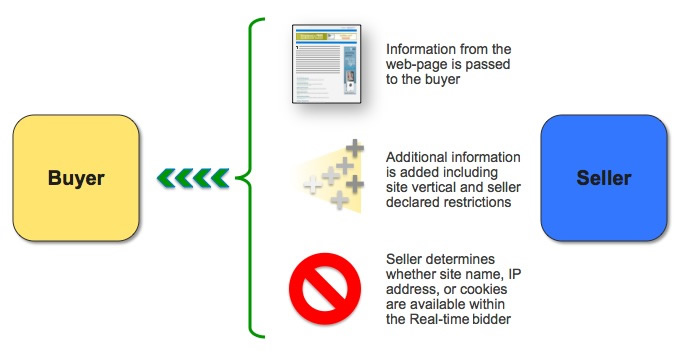במדריך הזה נספק סקירה כללית של המושגים של בידינג בזמן אמת (RTB) שנדרשים כדי לכתוב אפליקציות של בידינג שיכולות להשתתף בבידינג בזמן אמת של Authorized Buyers.
היסודות
אפליקציית בידינג יכולה לתקשר עם Google באמצעות אחד מפרוטוקולי ה-RTB הנתמכים. בקשת הצעת מחיר שנשלחת לאפליקציה מספקת הקשר לגבי הזדמנות להצגת מודעה אחת לפחות, כדי שמגיש הצעת המחיר יוכל לקבוע את נכס הקריאייטיב ואת סכום הצעת המחיר האופטימלי (אם יש כזה) לכל חשיפת מודעה. מגיש הצעת המחיר יכול להגיב עם תגובה להצעת מחיר כדי להגיש לפחות הצעה אחת ולציין את הקריאייטיב שיוצג בהזדמנויות להצגת מודעות שנשלחו בבקשה.

התרחיש הבא הוא אינטראקציה אפשרית אחת בין אפליקציית בידינג לבין Authorized Buyers:
- Google שולחת לאפליקציה של המגיש בקשה להצעת מחיר שמתארת חשיפה שמועמדת למכרז. החשבון של המגיש הצעות המחיר מוגדר לשימוש ב-OpenRTB בפורמט Protobuf, כך שהבקשה מגיעה כ-
BidRequestבסדרה, כפי שמופיע ב-openrtb.proto. במאמר עיבוד הבקשה מוסבר איך האפליקציה צריכה לפרש את בקשת הבידינג. -
אפליקציית המגיש מנתחת את הבקשה ומחילה את לוגיקת הבידינג שלה כדי ליצור
BidResponseשכולל הצעת מחיר ונכס קריאייטיב להזדמנות להצגת מודעה. לאחר מכן, האפליקציה מבצעת סריאליזציה של תגובת הצעת המחיר ושולחת אותה ל-Google. במאמר יצירת התגובה מוסבר איך האפליקציה צריכה ליצור ולשלוח תשובה לבידינג. -
תגובת הצעת המחיר מתקבלת והיא נכנסת למכרז הפתוח, שבו היא זוכה בחשיפת המודעות כי היא הצעת המחיר הגבוהה ביותר. כתוצאה מכך, הקריאייטיב שצוין בתגובה יוצג.
בחירת פרוטוקול
פרוטוקול הבידינג בזמן אמת מציין את האותות שבהם האפליקציה יכולה להשתמש כדי להעריך כל חשיפה שנשלחת בבקשה ולהגיש עליה הצעת מחיר, וגם איך ליצור תשובה. יש שתי דרכים לשנות את הפרוטוקול שמשויך לבקשה שלכם לבידינג:
- כדי לשנות אותו באופן ידני, פנו למנהל החשבונות הטכני.
- כדי לשנות אותו באופן פרוגרמטי, צריך להשתמש ב-Authorized Buyers REST API.
פרוטוקולים נתמכים
ב-Authorized Buyers יש תמיכה בשני פרוטוקולים של RTB:
- OpenRTB (Protobuf)
הטמעה של מפרט OpenRTB באמצעות Protobuf.
- OpenRTB (JSON)
הטמעה של מפרט OpenRTB באמצעות JSON.
מידע על מאגרי אחסון לפרוטוקולים
Protobuf הוא פורמט קוד פתוח לייצוג ולסריאליזציה של מידע מובנה.
אם רוצים להשתמש ב-OpenRTB Protobuf, צריך להתקין את המהדר של הפרוטוקול ואת סביבת זמן הריצה של Protobuf בשפה שבחרתם. לאחר מכן תוכלו להוריד את קובצי ה-proto שבהם אתם מתכוונים להשתמש ולהריץ את המהדר כדי ליצור ספרייה שיכולה לבצע סריאליזציה או דה-סריאליזציה של הודעות שהוגדרו ב-proto, כמו BidRequest או BidResponse. במאמר העזרה של Protobuf מוסבר איך לעשות זאת בכמה שפות.
עדכוני פרוטוקולים
פרוטוקולי ה-RTB ישתנו ככל ש-Google תוסיף תכונות חדשות ותפסיק להשתמש באחרות. נודיע על השינויים האלה הרבה לפני שהם ייכנסו לתוקף, כדי שיהיה לכם מספיק זמן להסיר את כל יחסי התלות של האפליקציה בשדות שנקבעו להוצאה משימוש. למידע נוסף על טיפול בשדות שהוצאו משימוש, ראו התאמה כששדות של בקשות הצעות מחיר הוצאו משימוש.
השלבים הבאים
בתוכן הבא מוסבר בפירוט רב יותר על המושגים של בידינג בזמן אמת:
- עיבוד הבקשה: איך לנתח ולפרש אותות שנמצאים ברוב הבקשות להצעות מחיר.
- יצירת התגובה: איך יוצרים תגובה להצעת מחיר, ואילו שדות מצוינים בדרך כלל בתגובה.
- מדריך OpenRTB: מסמך עזר להטמעה של מפרט OpenRTB ב-Authorized Buyers, בנוסף לתוספים ספציפיים ל-Authorized Buyers. מפורטות כאן תרחישי קצה והגבלות ספציפיים להטמעה הזו, ומזוהים שדות מקבילים בפרוטוקול של Google.
- דרישות להצגת מודעות של צד שלישי: הגדרת המדיניות שבה בעלי הצעות המחיר חייבים לציית כדי להשתמש בפורמטים שונים של מודעות, וכן מפרטי הטכנולוגיה של הפורמטים האלה.
- טירגוט מראש: איך מגדירים את אפליקציית הבידינג כך שתקבל רק חשיפות שתואמות לקריטריונים של הטירגוט.
- התאמות של קובצי Cookie: מסמך עזרה בנושא שירות ההתאמות של קובצי Cookie ושירותים קשורים אחרים, המשמשים לרימרקטינג.
- הגבלות על זמן אחזור וקישור בין רשתות (peering): פרטים על מיקומי המסחר ועל דרכים להפחתת זמן האחזור, למשל באמצעות קישור בין רשתות.
- בדיקה והשקה של האפליקציה: פרטים על תחילת הבדיקה של אפליקציית הבידינג עם תנועה שנשלחת על ידי Google בקנה מידה נרחב.

